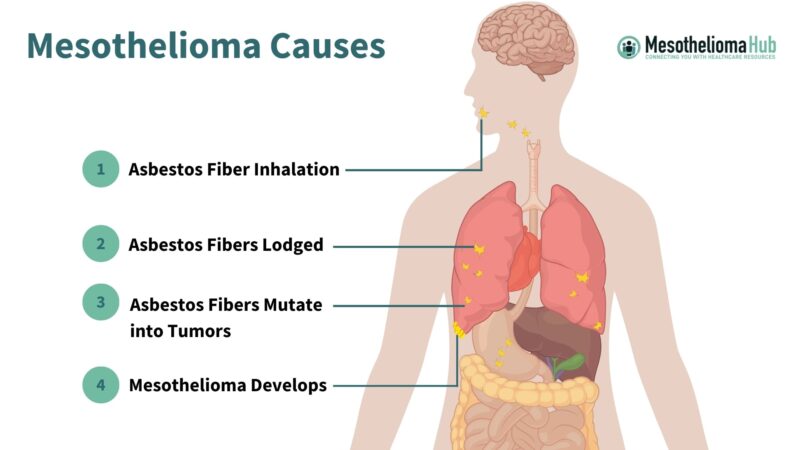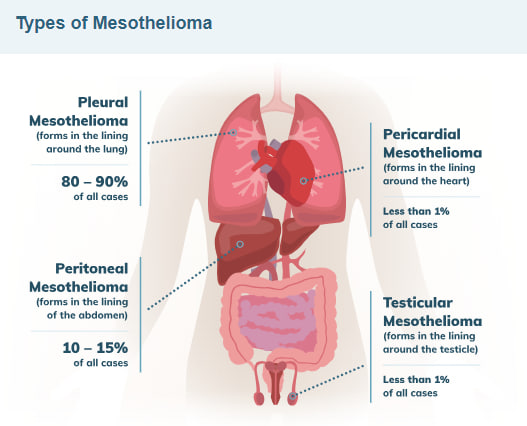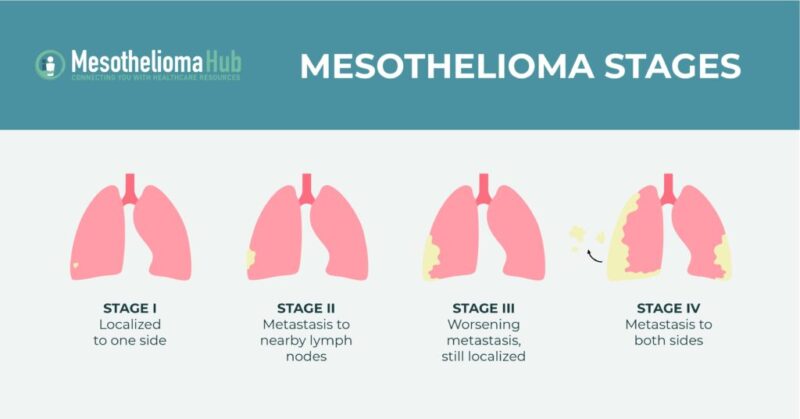What is Mesothelioma ?
Mesothelioma is a rare and aggressive cancer primarily associated with asbestos exposure, affecting the mesothelium, a thin layer of tissue covering most internal organs. It manifests in various forms depending on the affected area, with specific symptoms related to each type.
Epidemiology
Mesothelioma remains relatively rare globally, with an age-standardized rate (ASR) of approximately 0.30 per 100,000 persons. However, incidence rates vary significantly by region, with Northern Europe, Australia, New Zealand, and Western Europe reporting the highest rates. This variation largely reflects historical patterns of asbestos use, with countries that heavily utilized asbestos in the past experiencing higher incidence rates.
Causes and Risk Factors
The primary cause is inhalation or ingestion of asbestos fibers. These fibers can become lodged in the mesothelium, a thin layer of tissue that covers most internal organs, causing inflammation and genetic damage that leads to cancer. It has a long latency period, typically developing 20 to 50 years after initial exposure to asbestos. Other risk factors include living with someone who works with asbestos, previous radiation therapy to the chest or abdomen, and possibly exposure to other fibrous minerals like erionite. However, asbestos remains the most significant risk factor.

This image is taken from “Mesothelioma Hub”
Symptoms and Types
Mesothelioma manifests in various forms depending on the affected area, with specific symptoms related to each type.
Pleural Mesothelioma
This is the most common type, occurring in the lining of the lungs (pleura). It accounts for about 75% of all mesothelioma cases. Symptoms include:
- Chest pain
- Shortness of breath
- Painful coughing
- Fluid buildup around the lungs (pleural effusion)
- Unusual lumps of tissue under the skin on the chest.
Peritoneal Mesothelioma
Developing in the lining of the abdomen (peritoneum), this type represents about 10-20% of cases. Symptoms include:
- Abdominal pain
- Swelling or fluid in the abdomen
- Nausea
- Unexplained weight loss.
Pericardial Mesothelioma
A rare form that occurs in the lining around the heart (pericardium), comprising a very small percentage of cases. Symptoms can include:
- Chest pain
- Irregular heart rhythms
- Shortness of breath.
Testicular Mesothelioma
The rarest type, affecting the lining around the testicles. It may be first detected as swelling or a mass on a testicle.

This image is taken from mesothelioma.com
Diagnosis
Diagnosing mesothelioma is a complex process due to its rarity and the non-specific nature of its symptoms, which often resemble those of other, more common diseases. The diagnosis typically involves a combination of clinical evaluation, imaging tests, and biopsies.
1. Initial Evaluation
The diagnostic process usually begins with a detailed medical history and a physical examination. During this initial evaluation, doctors inquire about the patient’s symptoms, occupational history, and any known exposure to asbestos, which is the primary risk factor for mesothelioma.
2. Imaging Tests
Imaging tests play a crucial role in detecting abnormalities that may suggest mesothelioma and in determining the extent of the disease:
- X-rays: These are often the first imaging tests performed and can reveal thickening of the pleura, fluid accumulation (pleural effusions), or changes in the lung structure.
- Computed Tomography (CT) Scans: CT scans provide a detailed cross-sectional image of the body and are more detailed than X-rays. They are essential for assessing the size, location, and extent of the tumor.
- Magnetic Resonance Imaging (MRI): MRI scans offer high-resolution images and are particularly useful in assessing the diaphragm and the extent of tumor invasion into adjacent tissues.
- Positron Emission Tomography (PET) Scans: PET scans are used to detect cancer activity and can be helpful in staging the disease and monitoring response to treatment.
3. Biopsies
A biopsy is the definitive test for diagnosing mesothelioma. It involves the removal of tissue or fluid samples for microscopic examination by a pathologist to confirm the presence of mesothelioma cells.
4. Types of Biopsies
- Thoracoscopy/VATS (Video-Assisted Thoracoscopic Surgery): This procedure is commonly used for pleural mesothelioma. It involves making small incisions in the chest to insert a camera and instruments to obtain tissue samples.
- Laparoscopy: Similar to VATS but used for peritoneal mesothelioma, this procedure involves inserting instruments into the abdomen to obtain tissue samples.
- Fine Needle Aspiration (FNA): A less invasive method where a long, thin needle is used to extract tissue or fluid samples. This method is often guided by CT or ultrasound.
5. Analysis of Biopsy Samples
The pathologist examines the biopsy samples to determine the presence of cancer cells and to identify the type of mesothelioma cells (epithelioid, sarcomatoid, or biphasic), which can influence treatment decisions and prognosis.
Due to the complexity and similarity of symptoms to other conditions, it is crucial to involve specialists familiar with mesothelioma to ensure an accurate diagnosis and to guide treatment planning. Early and accurate diagnosis is essential for managing the disease effectively and improving the prognosis for patients.
Watch this short and informative video from “Imperial College London”
Staging
Mesothelioma is typically staged using the TNM system, which considers the size and extent of the tumor (T), whether cancer has spread to the lymph nodes (N), and whether there are metastases (M) to other parts of the body.
- Stage 1 – At this earliest stage, the cancer is localized to the mesothelial lining and has not spread to lymph nodes or distant sites. Treatment options are most varied and potentially curative at this stage, including aggressive surgical interventions.
- Stage 2 – The cancer has begun to spread beyond the original site to nearby tissues or lymph nodes but is still contained within the same general area. Surgery is often still an option, combined with chemotherapy or radiation therapy.
- Stage 3 – By this stage, mesothelioma has spread into surrounding tissues, organs, or more distant lymph nodes. Treatment typically focuses on managing symptoms and may include less aggressive surgery, chemotherapy, radiation therapy, or a combination of these treatments to control the disease and improve quality of life.
- Stage 4 – The most advanced stage of mesothelioma involves widespread metastases to distant organs. At this point, curative treatment is not possible, and care focuses on palliative treatments to relieve symptoms and improve quality of life. This may include chemotherapy, targeted therapy, and supportive care measures.

This image is taken from “Mesothelioma Hub”
Patterns of Metastasis
The most common organs to which mesothelioma metastasizes include the liver, lungs, adrenal glands, and kidneys. These patterns of metastasis are observed across various studies and sources:
- Liver: The liver is frequently mentioned as a common site for mesothelioma metastasis. It was noted as the most common metastatic site in a study of 171 cases, occurring in 55.9% of those cases. Another source also highlights the liver as a prevalent site for metastasis in mesothelioma.
- Lungs: The lungs are another common site for metastasis, especially for pleural mesothelioma, which originates in the lining of the lungs. This type of mesothelioma can spread to the opposite lung or other parts of the lung area.
- Adrenal Glands: The adrenal glands are also frequently affected by metastatic mesothelioma. This was observed in 31.3% of cases in one study.
- Kidneys: The kidneys are another common site for mesothelioma metastasis, with 30.1% of cases showing involvement in one study.
These organs represent the most typical sites where mesothelioma spreads, reflecting the aggressive nature of this cancer and its tendency to affect multiple organs as it progresses.
Treatment
Mesothelioma treatment involves a variety of approaches depending on the stage of the disease, the type of mesothelioma, and the overall health of the patient. The main treatment options include surgery, chemotherapy, radiation therapy, immunotherapy, and multimodal therapy, which combines several of these treatments.
1. Surgery
Surgery for mesothelioma aims to remove the cancer or reduce symptoms. The type of surgery depends on the mesothelioma’s location and the patient’s health:
- Extrapleural Pneumonectomy (EPP): This extensive surgery involves removing one entire lung, part of the lining of the chest, the diaphragm, and the sac around the heart.
- Pleurectomy/Decortication (P/D): This less radical surgery removes the lining of the lung and as much disease as possible while sparing the lung.
- Cytoreductive Surgery: Used primarily for peritoneal mesothelioma, this surgery removes as much of the tumor as possible, often combined with heated intraoperative chemotherapy (HIPEC).
2. Chemotherapy
Chemotherapy uses cytotoxic drugs to kill cancer cells and is a cornerstone of mesothelioma treatment. Commonly used drugs include pemetrexed (Alimta) and cisplatin, which may be used alone or in combination. Chemotherapy can be administered before surgery (neoadjuvant) to shrink tumors, after surgery (adjuvant) to kill remaining cancer cells, or as a standalone treatment to manage symptoms and improve quality of life.
3. Radiation Therapy
Radiation therapy involves the use of high-energy rays to target and kill cancer cells. It is often used in conjunction with other treatments as part of a multimodal approach. Radiation can be delivered externally or internally (brachytherapy) and is particularly useful for controlling local tumor growth and alleviating symptoms such as pain.
4. Immunotherapy
Immunotherapy is a newer form of treatment that boosts the body’s immune system to fight cancer. The FDA-approved combination of nivolumab (Opdivo) and ipilimumab (Yervoy) has shown promise in treating mesothelioma, particularly in cases where surgery is not an option. Immunotherapy can be used alone or in combination with other treatments, such as chemotherapy, in a multimodal approach.
5. Multimodal Therapy
Multimodal therapy combines two or more treatment modalities, typically surgery, chemotherapy, and radiation therapy, to maximize the effectiveness of treatment. This approach is often considered the best strategy for managing mesothelioma, as it attacks the cancer from multiple angles, potentially improving survival rates and quality of life.
Survival Rate and Prognosis
The survival rate and prognosis for mesothelioma patients vary significantly based on several factors, including the stage of the disease, cell type, patient’s age, overall health, and the treatments received.
Stage-Based Survival Rates
Mesothelioma survival rates are closely linked to the stage of the disease at diagnosis. The stages indicate how far the cancer has spread and help guide treatment decisions:
- Stage 1: The cancer is localized. Survival rates are higher, with a median survival of 21 to 51 months.
- Stage 2: Cancer has begun to spread to nearby structures or lymph nodes. Median survival ranges from 19 to 26 months.
- Stage 3: Further spread to more distant structures or lymph nodes, with median survival between 15 and 16 months.
- Stage 4: Cancer has spread to distant parts of the body. The prognosis is poor, with median survival ranging from 8 to 12 months.
Cell Type-Based Survival Rates
The type of cells involved in mesothelioma also affects prognosis:
- Epithelioid: The most common and has the best prognosis, with higher survival rates due to slower spread and better response to treatment.
- Sarcomatoid: The least favorable prognosis, characterized by rapid spread and poor response to treatment.
- Biphasic: Features both epithelioid and sarcomatoid cells. Prognosis and survival rates depend on the dominance of cell types.
Overall Survival Statistics
The general survival rates for mesothelioma after diagnosis are as follows:
- 1-year survival rate: Approximately 43.7%.
- 3-year survival rate: Around 16.8%.
- 5-year survival rate: About 12%.
These statistics reflect the aggressive nature of mesothelioma and its resistance to many traditional cancer treatments.
Watch this video story from a patient with Mesothelioma
In summary, mesothelioma remains a challenging cancer with a generally poor prognosis. Survival rates vary widely based on the stage at diagnosis, cell type, treatment regimen, and individual patient characteristics. Ongoing research and clinical trials continue to seek better ways to treat and manage this aggressive disease, offering hope for improved outcomes in the future.
Resources
- American Association of Cancer Research – aacr.org
- Cancer Research UK – cancerresearchuk.org
- Epidemiology and Clinical Aspects of Malignant Pleural Mesothelioma – PubMed
- Imaging in Pleural Mesothelioma: A Review of the 13th International Conference of the International Mesothelioma Interest Group – PubMed
- American Society of Clinical Oncology (ASCO) – Cancer.net
- Nasopharyngeal Cancer Treatment – PubMed
- National Cancer Institute – cancer.gov
- American Cancer Society – cancer.org
- OncoDaily


